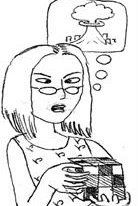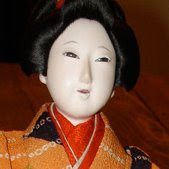As promised, here are the rest of the images scanned from my antique copies of Tale of Two Cities. Enjoy!
Lucie is forced to testify against Darnay, her future husband at his capitol trial in London. Her distress is noted by Sydney Carton who is assistant to Charles' defense lawyer, Stryver.
This for me is one of the iconic pictures of Lucie. I think that Raphaelo Busoni, who illustrated the Junior Illustrated Classics edition of Tale of Two Cities (which sadly went out of print after my childhood) depicts a Lucie as both thoughtful and lovely. His faces tend to be rather angular and squarish, which makes his Lucie slightly different than the other ones I've seen. Apparently Busoni's Lucie also likes the colour blue. I find it kind of a fun coincidence that one of Lucie's paralells, the seamstress is wearing bright blue in Busoni's final scene.
*Everyone* illustrates this scene. The revolutionaries sharpen their knives outside of the window of the closed Paris branch of Telson's Bank. The Manettes and Lorry are living upstairs and their window overlooks the crazed mob preparing to slaughter the prisoners of La Force. The massacre of these prisoners is a real event during which many royalists were tortured and murdered--dragged out into the streets by the mob. Princess Lamballe was brutally killed and beheaded. Her head was paraded on a pike before the window of her best friend...Marie Antoinette. This picture, of all of the grindstone scenes captures the hellishness and drunken action of this scene the best. The sociopathic behaviour of the mob and their devilish glee imbues this depiction. I don't know the illustrator...they aren't credited in the frontspiece of the book. This illustrator's images were in many of the turn of the century copies of TOTC, but his illustrations are fairly rare in modern versions.
Here's another one by the same illustrator. This scene isn't terribly commonly illustrated, but it's one of my favourites. Doctor Manette's sanity is finally broken as his past tragedy is dragged out in a very public and devastating way in order to condemn his son in law whom he loves.
Sydney Carton supports him--he too is undergoing a metamorphosis. Sydney Carton's facade of insolence and carelessness is falling away, revealing a gentle and broken but intelligent and pragmatic man who is committed to his own redemption.
Charles Darnay has been reduced to a frightened and desperate shell as he counts the hours until his death and tries to detach himself from his memories of Lucie and their daughter.
This painting by Harvey Dunn captures Charles' heartbreaking fall into helplessness (While is double assumes a position of power and control). Charles looks like a frightened animal. Harvey Dunn is a fairly well known Western artist. Tale of Two Cities is quite a departure from his usual work. He does the best work when illustrating the peasant scenes, and he definitely seems to prefer these. A few of his scenes, including the scene of the last chapter are rendered fairly awkwardly and in garish colours. I find this picture of Charles haunting, though.
This picture is from the Heritage Edition, and is by Rene Ben-Susan, a fairly well-known French illustrator. I find myself getting more and more fond of Ben-Susan's illustrations. He's drawn a small vignette at the beginning of each chapter , so the size of this picture on your screen is about the size of the picture in real life. I enjoy the illustrator's stylized profiles and head-on perspectives, and how he draws the details of the clothing with as few lines as possible.
This is Sydney Carton speaking with the diabolical wood-sawyer, who ironically encourages him to go watch the work of the guillotine as a spectator. With amazing restraint, Carton carries on a brief, morbid conversation with the wood-sawyer about how many pipes the wood-sawyer can smoke until the executions of dozens of people is finished. This desensitization to the brutaility of the terror contrasts with the following scene where Carton prepares for his own death.
Sydney Carton rides to his death at the guilotine with a young French seamstress who has been wrongly convicted of plotting against the republic. They find comfort and solace in each-other to the end.
This depiction by A. Dixon is almost ethereal. The seamstress is both beautiful and sad, and the light outlines around both of their faces is either ghostly or angelic.
This is my favourite TOTC illustration.
And, on a slightly lighter note, I leave you with this one by an unknown illustrator. This has to be the most badass Sydney Carton ever. They're only executing him because he's *letting* them. He could seriously WTFPWN both of these pansies at any time.
Saturday, September 26, 2009
Subscribe to:
Post Comments (Atom)









2 comments:
Does anyone ever illustrate the "Hand at Cards" chapter? I love that part, and I don't think I've ever seen an illustration of it.
Actually, there are two that I know of. I will post those above.
Post a Comment